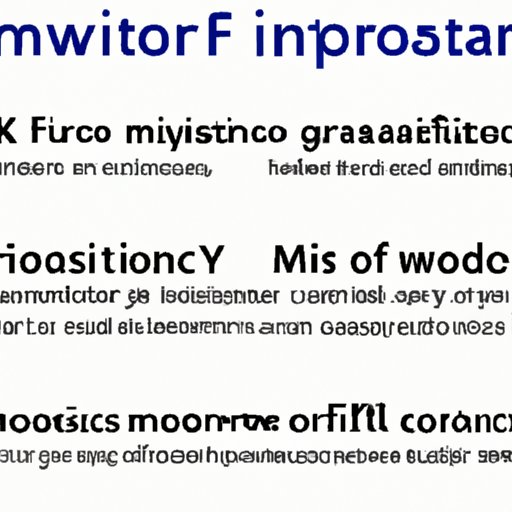
How to Clear Format in Word: A Comprehensive Guide
Microsoft Word is an incredibly useful tool for creating documents, reports, and other written content. However, formatting issues can often arise, which can be incredibly frustrating to deal with. Incorrect formatting can make documents look sloppy, unprofessional, and can even cause printing or sharing problems. Fortunately, there are ways to easily clear formatting in Word, which can save time and ensure that documents look their best.
Step-by-Step Guide
Clearing formatting in Word is a simple process that can be done in just a few clicks. Follow these steps to clear formatting in Word:
- Open your Word document
- Highlight the text that you want to clear the formatting from
- Locate the ‘Clear Formatting’ button on the ‘Home’ tab of the ribbon
- Click on the button
- The selected text will now have the formatting removed
If you need to clear formatting for an entire document, simply select all the text (using the shortcut Ctrl+A), and then follow the same steps to clear the formatting.
It’s important to note, however, that clearing formatting removes all formatting from the selected text. This includes font styles, colors, sizes, bold and italic text, and anything else.
Tips for Avoiding Common Formatting Issues
While clearing formatting is a great solution for fixing issues, it’s always better to prevent issues from happening in the first place. Here are a few tips for avoiding common formatting problems in Word:
- Use styles instead of directly formatting text
- Use the built-in templates for documents
- Check for hidden formatting issues using the ‘Show/Hide’ button on the ‘Home’ tab
- Avoid copying and pasting text from other sources
Keyboard Shortcuts
Another way to clear formatting in Word is by using keyboard shortcuts. These can save time and increase productivity, especially for frequent Word users. Here are a few keyboard shortcuts to try:
- Ctrl + Spacebar to remove all character formatting
- Ctrl + Q to remove paragraph formatting
- Ctrl + Shift + Z to redo
- Ctrl + Shift + A to change the selected text to all caps
Keyboard shortcuts are a great way to increase efficiency and productivity while using Word. It may take some time to learn the different commands, but once you do, you’ll be able to format and clear formatting with ease.
Video Tutorial
If you’re a visual learner, a video tutorial can be a great way to learn how to clear formatting in Word. Here’s a step-by-step video tutorial that demonstrates the process:
This tutorial covers more complex formatting issues, such as removing formatting from tables or images, and working with specific font styles.
Quick Tips
If you need to clear formatting quickly, there are a few simple solutions that can help:
- Use Ctrl+Space to remove character formatting
- Use Ctrl+Shift+N to apply the ‘Normal’ style to the selected text
- Use Ctrl+Shift+Z to redo
These quick tips can save time and make the formatting process much smoother.
Common Mistakes
There are a few common mistakes that users make when trying to clear formatting in Word. Here are a few issues to look out for, and how to solve them:
- Hidden formatting: Sometimes, formatting can be hidden in Word documents. Use the ‘Show/Hide’ button on the ‘Home’ tab of the ribbon to reveal any hidden formatting, and then clear it.
- Specific font styles: If you’re having trouble clearing formatting for a specific font style, try selecting the text and then changing the font to ‘Times New Roman’ (or another standard font). Clear the formatting again, and then change the font back to the desired style.
- Removing line breaks: To remove line breaks, use the ‘Find and Replace’ feature (Ctrl + H) to find ‘^p’ (which represents a paragraph mark) and replace it with a space.
Conclusion
Clearing formatting in Word doesn’t have to be a daunting task. By following the simple steps outlined in this article, readers should be able to clear formatting quickly and easily. Additionally, by using keyboard shortcuts, video tutorials, and quick tips, users can make the formatting process even smoother. Remember to avoid common mistakes, and use styles and templates instead of direct formatting whenever possible. By doing so, documents will look professional and polished, and formatting issues will be a thing of the past.




